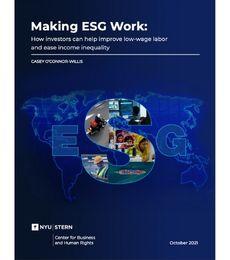Research Highlights
Making ESG Work: How Investors Can Help Improve Low-wage Labor and Ease Income Inequality
—

The market for investment strategies that incorporate environmental, social, and governance (ESG) factors is booming, but the analysis of social factors remains limited and ill-defined. Investors are increasingly interested in closing this gap. To do so, asset managers and ESG data providers must overcome several hurdles. Most importantly, they must decide what social concerns to prioritize and begin to assess corporate social performance more rigorously.
The Covid-19 pandemic has both exposed and exacerbated a growing economic divergence between high- and low-wage workers. A new report from the NYU Stern Center for Business and Human Rights, “Making ESG Work: How Investors Can Help Improve Low-wage Labor and Ease Income Inequality,” argues that investors should view this as a priority concern for the "S" in ESG and deepen their assessment of the quality of the low-wage work that companies rely on.
The report’s author, Casey O’Connor-Willis, senior program manager and research scholar at the Center, offers recommendations for fixing the “S,” including:
To asset owners, investment consultants, and asset managers:
The Covid-19 pandemic has both exposed and exacerbated a growing economic divergence between high- and low-wage workers. A new report from the NYU Stern Center for Business and Human Rights, “Making ESG Work: How Investors Can Help Improve Low-wage Labor and Ease Income Inequality,” argues that investors should view this as a priority concern for the "S" in ESG and deepen their assessment of the quality of the low-wage work that companies rely on.
The report’s author, Casey O’Connor-Willis, senior program manager and research scholar at the Center, offers recommendations for fixing the “S,” including:
To asset owners, investment consultants, and asset managers:
- Acknowledge the need to significantly revise and strengthen the “S” in ESG and direct sufficient resources to tackling this challenge.
- In strengthening the “S,” place greater emphasis on the quality of low-wage work and the extent to which outsourcing practices are contributing to lower-paying, precarious jobs. This will entail encouraging companies to report more and better data relating to employment practices, especially for outsourced labor.
- Asset owners and investment consultants should demand and incentivize better social assessments from asset managers and ESG ratings agencies, particularly relating to outsourced labor practices.
- Asset managers should:
- Revise and strengthen the metrics for the “S” in ESG funds and offer greater transparency to investors regarding how funds currently define and evaluate the “S” category, including the data on which these measures are based.
- Offer interested investors ESG funds that conduct more rigorous assessments of companies’ social performance, even if short-term returns on such investments are not comparable to other funds.
- Prioritize updating the “S” component of measurement systems with a particular emphasis on causes of income inequality, including corporate outsourcing practices.
- Develop more and better metrics for assessing outsourcing practices, shifting away from a primary focus on company policies, audits, grievance systems, and controversies.
- Better integrate assessments of financial performance and ESG performance. This means that assessments should flag when a company’s profitability or market share reflect or create heightened risk for labor abuse.
- Ensure that asset owners and managers can legally consider investors’ and beneficiaries’ environmental and social objectives in addition to their financial goals. In the U.S. context, this will require revising “fiduciary duty” requirements to ensure that the “best interests” of investors captures more than just maximum risk-adjusted financial returns.
- Expand mandatory corporate reporting to include specific metrics for both direct employees and outsourced workers. These should include, at a minimum, information on the costs associated with these workforces, the nature of worker contracts, the location of workers, and the turnover rate of workers and suppliers.
- Enhance the reporting requirements of institutional investors to include greater specificity regarding how “E,” “S,” and “G” factors are evaluated and what happens when these issues conflict with each other or with financial returns. New reporting requirements should also include greater transparency into how ESG funds factor these issues into their stewardship practices and proxy voting.
